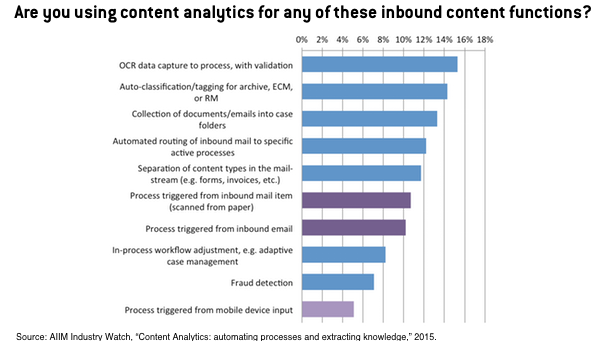
Have you ever taken time to look at your organization’s information management practices and assess how they interact with your business processes? Have you stopped to determine where content is coming from, where it goes and what happens to it? Have you identified the people in the process interacting with that information, and why? These are all essential and valid questions to ask in today’s multi-dimensional workplace, with multi-channel input from a wide variety of sources, and a place where content analytics can prove beneficial in automating business operations.
The first step for many analytic processes begins with multi-channel capture and recognition. The range of sources spans from paper, to emails and other inbound channels, which could include office productivity tools. This in itself involves validation and some “intelligent guesswork” based on word matching and sentence construct.
A recent AIIM Industry Watch Report titled “Content Analytics: automating processes and extracting knowledge” finds that 34% of responding organizations are using content analytics for process automation, information governance, contextual search or business insight. A further 44% have plans in place. The most popular application has been invoice processing (accounts payable) where invoices are recognized out of the inbound mail, examined for layout of key fields and optical character recognized (OCR'd) to capture the actual data. This is then validated against the original purchase order data from the finance system.

Consider this
Content analytics is rapidly gaining a place among the corporate toolset. While the initial focus may be on business insight (Big Data/Big Content), there is potential for and benefit to be gained using analytics for enhancing and streamlining workflows, improving search and strengthened compliance. There is increasing interest and adoption by business organizations in the use of recognition and routing of inbound content. This is tied to automated classification of records and email, metadata addition and correction and all of the improvements in access, security, de-duplication and retention that are gained as a result.
Managing the growing influx of multi-channel inbound content is increasingly difficult if you are relying solely on manual processes and human interaction. Businesses are now realizing and accepting that automated handling is as accurate and more consistent than humans. Email archiving, in particular, presents a dilemma, and content analytics offers a way to carry out defensible deletion in line with information governance polices.
What to think about
Unless you have well-defined processes, users who are diligent and consistent at declaring, classifying and tagging records and a way to audit and ensure processes and classification are, in fact, carried out properly, you consider investing in auto-classification assistance or full auto-classification. In this light, you must also ensure your information governance policies are updated and periodically refreshed as they provide the rules for automated agents.
In my view
In my view, inbound content handling can, and typically does, rapidly overload process staff and customer response times. Planning for and implementing a multi-channel inbound communications and capture strategy is essential to getting control and consistency over your captured content. Use of analytics enhances this capability, enabling the automation of key processes, strengthening compliance defensibility and supporting a multi-dimensional information management environment. Look across the range of your business activities to see where content analytics could provide an opportunity to automate and improve your competitive advantage.
Bob Larrivee is vice president of market intelligence at at AIIM and an internationally recognized subject matter expert and thought leader with over 30 years of experience in the fields of information and process management. He is an avid techie with a focus on process improvement and the application of advanced technologies to enhance and automate business operations. Follow him on Twitter @BobLarrivee.






















